The world of dental aesthetics has seen significant advancements in dental technology. One notable development is veneers, which are thin pieces designed to replicate the appearance of the natural tooth. Addressing the question of “What are veneers?”, they are installed to cover the front surface of a tooth to improve appearance, providing a natural and pleasing look.
The veneers adhere to the teeth to alter their dimensions. The adhesive process is done with proper care to ensure a firm and lasting bond to the original tooth. Veneers offer a solution to various dental concerns, from staining to gaps and misalignments.
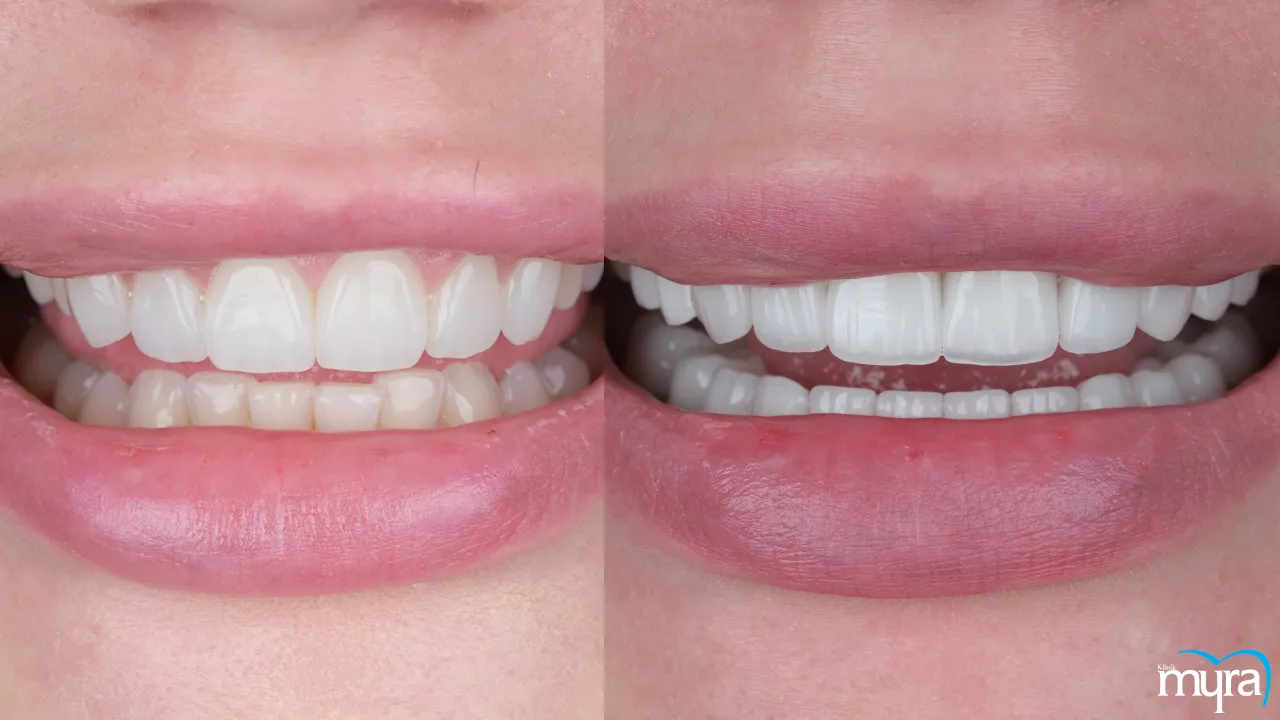 There are a variety of materials used in crafting veneers. One prevalent material is porcelain. Porcelain veneers are known for their durability and the ability to resist staining, allowing for a lasting solution for individuals seeking to enhance their smiles.
There are a variety of materials used in crafting veneers. One prevalent material is porcelain. Porcelain veneers are known for their durability and the ability to resist staining, allowing for a lasting solution for individuals seeking to enhance their smiles.
Composite resin is another material used in veneer crafting. Different materials mean multiple options for individuals to choose from. One that suits their needs and preferences is easy to find across the range of available materials with differing characteristics, from durability and appearance to cost.
Lumineers are thinner versions of the standard veneers, requiring minimal to no removal of the tooth surface before application. Composite veneers are built straight up into the mouth and are less destructive to the natural tooth structure. Each type provides distinct advantages and attributes, allowing for personalised dental aesthetic solutions.
Multiple factors affect veneers’ cost. The total cost involves several expenses, from the price of the veneer itself and the professional fees to any additional treatments necessary. Other factors that affect the total cost range from the chosen veneer type and the complexity of its application process to the geographic location of the dental practise. Many find the investment worthwhile despite the considerable cost, as it provides a great boost in appearance and confidence.
Veneers are a versatile and sought-after cosmetic dental solution. They present a viable option for individuals wishing to rectify a range of aesthetic dental concerns, offering a blend of durability and a natural look. The variety in materials and types of veneers allows individuals to find the perfect match that aligns with their needs and budget while considering the long-term benefits and value of an enhanced and good-looking smile.
What Is Veneer Teeth?
Veneer teeth are pieces installed on top of teeth designed to enhance the smile’s aesthetic appeal. Veneer teeth cover imperfections in a tooth, from its colour and shape to its size and appearance. They are thin coverings placed on the front part of the teeth to improve dental aesthetics. Veneers provide a natural and inviting look, offering a transformative solution for individuals keen on enhancing their smiles.
Dental professionals prioritise precision and meticulousness when crafting veneers. Every veneer is tailored to fit the individual tooth it is meant to cover, ensuring a seamless and natural appearance. The customization involves a detailed examination of the tooth’s characteristics, from its structure and shade to its general look. Attaching veneers involves several processes, from tooth enamel removal for the veneer’s installation to the application of a strong bonding material to secure the veneer to the tooth.
The effectiveness and appeal of veneer teeth have resulted in their popularity and adoption. Individuals seeking to rectify a range of issues, from discoloration and chips to other irregularities in their teeth, find veneers to be a compelling solution. Veneers continue to evolve as dental technology advances, offering enhanced durability and aesthetic appeal. They are a significant breakthrough in cosmetic dentistry.
What Is the Purpose of Veneers?
The purpose of veneers is to address various orthodontic issues, focusing on enhancing how the teeth look. Veneers improve how the teeth appear by altering their characteristics, from their size and colour to their length and shape. Individuals with dental problems ranging from staining to damages and misalignments find veneers a reliable remedy.
Veneers are a resilient substitute for other forms of cosmetic dentistry, allowing individuals to eat and drink without worrying about damaging them. They impart strength to the existing tooth foundation and resist stains, such as from tea and cigarette smoke, making them a suitable choice to maintain a pristine smile.
The incorporation of veneers involves a comprehensive strategy, starting with dental professionals’ assessment of a patient's needs and preferences before recommending veneers as an appropriate option for treatment. Their design and application require precision and expertise to guarantee a natural appearance and sensation. Their effectiveness in resolving dental imperfections highlights their importance in dental cosmetics. Veneers have become a go-to for augmenting the teeth’s aesthetics and function.
What Is the Process of Getting Dental Veneers?
The process of getting dental veneers is listed below.
- Schedule an initial consultation. The consultation includes discussions about the patient’s needs and preferences, followed by a recommendation about whether a veneer is the best course of action. Consulations guarantee that every aspect of the procedure is clear and personalised. Understanding and agreeing upon expectations and outcomes during consultation is ideal before moving forward.
- Provide teeth impressions. Tooth impressions are the blueprint for creating the veneers, which are done after the initial consultation. The impressions guide the dental laboratory technicians in shaping the veneers to align with the patient’s dental structure. The precision of the impressions has a direct correlation with the fitting accuracy of the veneers.
- Apply temporary veneers. A dentist places temporary veneers to safeguard the teeth while the custom-made ones are being fabricated. They are a protective layer that averts any discomfort or tooth sensitivity. They help with adapting to the sensation of having veneers.
- Ensure precise veneer fabrication. The fabricators use the tooth impressions for the meticulous crafting of the veneers. Attention to detail is a major requirement, as it determines the veneers’ aesthetic and functional quality. They are ready for attachment after completion.
- Prepare the teeth. The dentist prepares the teeth by removing a small amount of the enamel. The removal is necessary to accommodate the veneers and secure an optimal and natural fit. Correct preparation lays the groundwork for the actual placement of veneers.
- Fit the veneers. It involves placing the fabricated veneers on the teeth to assess their fit and appearance. Necessary adjustments are carried out to ensure comfort and to rectify any discrepancies in characteristics such as size or fit. A meticulous fit helps with the veneers’ longevity and comfort.
- Bond the veneers. The dentist uses a specialised permanent adhesive to bond the veneers to the teeth. The application of a light beam hardens the adhesive, solidifying the bond between the two. Proper bonding guarantees the veneers’ stability and durability.
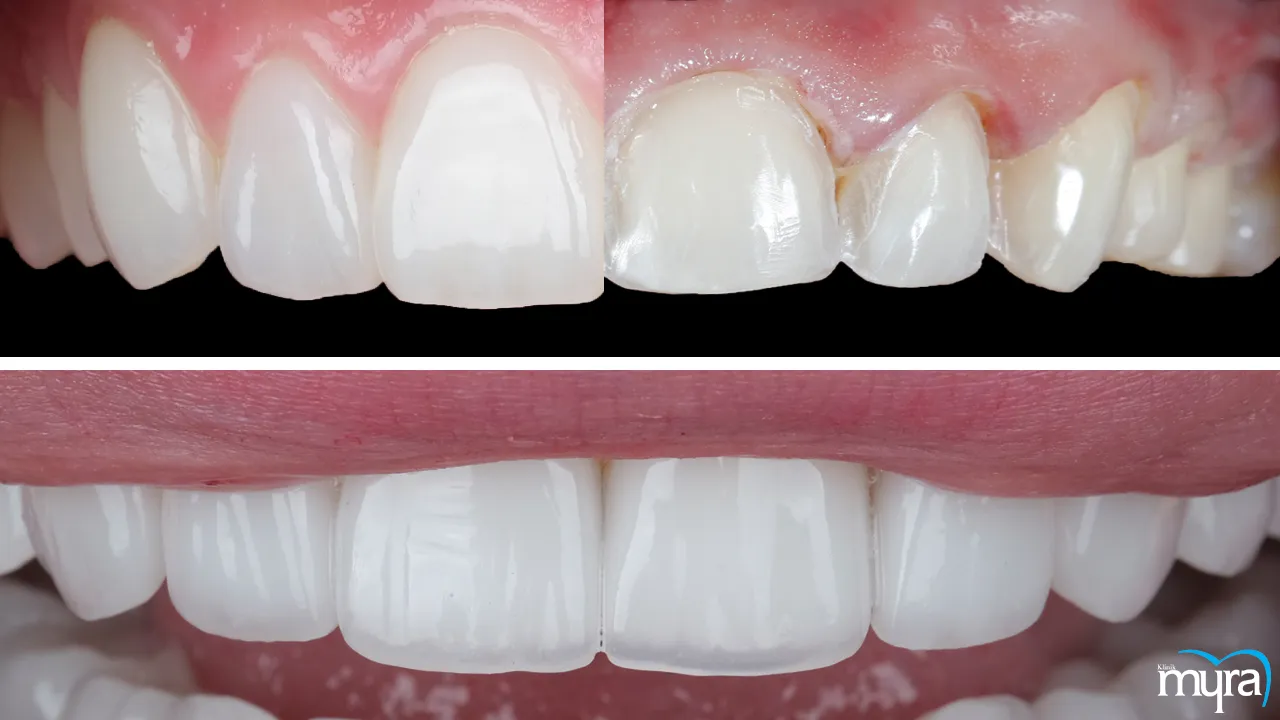
How Much Does a Veneer Cost in Turkey?
A veneer costs in Turkey as little as £200. Veneers have different prices depending on the type installed and the materials that are used. For example, a laminate veneer goes for £265 in Turkey, a country renowned for its inexpensive dental care.
Zirconia veneers in Turkey are priced at £175, which is consistent with the cost of traditional porcelain veneers. Lumineers is a specific brand of veneers known for their minimal prep requirements and durability, but it is more expensive at £220. The price variance is huge across many options, ensuring that a patient finds an appropriate solution within their budget.
Other elements factor into the price, ranging from the dentist's expertise and reputation to the complexity of the dental condition and any added services or treatments necessary. Many Turkish dental clinics offer an added advantage in that they do not levy consultation fees. The lack of initial costs makes the overall expenditure even more attractive to those seeking dental procedures in Turkey.
What Are the Different Materials for Veneers?
The different materials for veneers are listed below.
- Porcelain: Porcelain is the top choice for veneers. It complements natural tooth enamel well because of its translucency. Dentists and patients appreciate its durability, making it a long-lasting choice for veneers. Resistance to staining is another noteworthy attribute, ensuring that the bright and vibrant smile remains consistent over time.
- Ceramic: Ceramic is another sought-after choice for veneer material. Ceramic replicates the luminosity of natural teeth and offers a realistic finish. It's a biocompatible option, allowing for minimal irritation or allergic reactions in patients. The strength of ceramic veneers is comparable to that of porcelain ones, making them a worthy consideration in attaining a natural look.
- Zirconia: Zirconia offers exceptional strength and durability. It’s one of the toughest materials available for dental procedures and guarantees long-term wear without compromising on aesthetics. The translucency of zirconia is a good match for natural teeth, and it’s difficult to distinguish it from real ones. Its robust nature means fewer chances of chipping or damage, even more so for patients who grind their teeth.
- Composite Resin: Composite resin is a versatile and affordable option. It's a direct veneer option, meaning dentists apply and sculpt it directly onto the patient's teeth in a single visit. It’s less durable than the other options, but its ease of repair and lower cost make it an attractive option for many. It allows for minor adjustments and refinements over time, ensuring a tailored and optimal fit.
1. Porcelain
Porcelain is a material made from clay and silica, among others, that undergoes high-temperature firing to achieve its finished form. Its natural translucence is a close mimic of human tooth enamel, making it a preferred choice for dental veneers. Dentists began using porcelain for veneer installations in the early 1980s after recognising its aesthetic appeal and durability.
Two significant advantages of porcelain veneers are their long lifespan and resistance to staining. Porcelain veneers last many years with proper care and are resistant to discoloration. They enhance the smile with consistency over time.
Porcelain veneers’s disadvantage is the necessity of tooth enamel removal, which is irreversible, during the installation process. They're a bit more brittle than natural teeth. It’s not a cause for concern, but exercising caution is best to avoid chipping them.
Porcelain veneers come at a higher initial cost compared to other materials, such as composite resin. Their longevity and minimal maintenance make them cost-effective in the long term. They require fewer replacements and repairs, lowering the total expense over time.
2. Ceramic
Ceramic originates from natural clay materials and achieves its final form after high-temperature firing. It has similar features to porcelain, such as its translucency, which makes it a great material for dental veneers. The tooth-like look of ceramic allows for a seamless blend with natural teeth. Ceramic and porcelain veneers were invented in the 1920s but became mainstream during the 1980s after technological advancements, such as the use of hydrofluoric acid to help with bonding.
Ceramic veneers are known for their ability to resist staining and their strength. They maintain their colour over time and keep the smile radiant for longer. The durability reduces the risk of damage from daily wear.
Ceramic veneers share the same weaknesses as porcelain ones. They require tooth enamel removal, which is a permanent change to the teeth. They are more susceptible to cracking under extreme force or pressure compared to natural teeth.
Ceramic veneers are cost-effective in the long term, even if they're expensive upfront. They last for up to 15 years before a replacement is needed. Their long-lasting nature and reduced need for frequent replacements or repairs make them a worthy investment for many seeking a lasting smile solution.
3. Zirconia
Zirconia is a crystalline material known for its strength and durability. It originates from zirconium dioxide, exhibiting properties that make it ideal for various veneers. It’s the strongest material on the list, despite being thinner when crafted. Zirconia has been in wide use since the 2000s, becoming more popular with the rise of CAD/CAM technology in dentistry.
Zirconia veneers’ durability is unmatched. They have the best resistance against wear and tear while offering better translucency, mimicking teeth’s natural appearance that results in a natural-looking smile. Zirconia veneers demand extra precision during installation, as even a slight oversight during the process compromises the fit. Its rigidity is a double-edged sword, as it has a higher chance of wearing down opposing natural teeth due to its hardness.
Zirconia veneers are the most expensive due to the material’s strength and the machinery needed to craft them. Their cost-effectiveness lies in their added durability and longevity. Replacements and repairs are less frequent throughout their lifespan, making them a wise investment.
4. Composite Resin
Composite resin consists of a mixture of plastic and fine glass particles. Its adaptive nature and aesthetic appeal have made it a reliable material for dental veneers. It has been in use since the 1960s and has become better over the years, becoming even more versatile and adaptable in veneer installations.
Composite resin veneers call for a less invasive procedure. They require minimal tooth enamel reduction, allowing for greater tooth structure preservation. Another benefit is that they are quick and easy to install, with dentists performing direct application to and sculpting on the teeth within one visit.
Composite resin veneers are more susceptible to staining. They require diligent oral hygiene to maintain their appearance. They wear down quicker than other veneer types, requiring more frequent replacements.
Composite resin veneers are an economical alternative to other veneer materials. They are cheap, making them an attractive option for immediate cosmetic improvements. Their shorter lifespan and increased risk of staining mean additional expenses for maintenance and replacements over time.
What Are the Different Types of Veneers?
The different types of veneers are listed below.
- Lumineers: Lumineers are composed of proprietary cerinate porcelain. They are notable for their extreme thinness, comparable to a contact lens. Dentists apply them on top of teeth without requiring any tooth reduction, making the process reversible. Many patients opt for Lumineers due to their little-to-no tooth damage and guarantee of a painless experience.
- Composite Veneers: Composite veneers consist of a mixture of plastic and fine glass particles. Dentists perform direct application and shaping on the teeth in a single visit, without any need for intricate pre-fabrication. They are a cheap alternative, but they face the added risk of staining and a shorter lifespan.
- Zirconia Veneers: Zirconia veneers are crafted from zirconia, a material known for its extreme strength. They possess a translucency that mimics the look of natural tooth enamel. Zirconia veneers resist wear and chipping, making them an attractive option for posterior teeth. Their strength and durability factor into their higher price compared to other veneer types.
- Snap-On Smile: The Snap-On Smile is a removable arch that snaps over existing teeth. It’s made of a thin and strong dental resin that provides a temporary solution for cosmetic dental issues. It’s beneficial for patients looking for an affordable and non-invasive smile enhancement. Patients use them for special events or as a temporary measure before committing to permanent veneers.
- Microthin Veneers: Microthin veneers possess extreme thinness and are designed to fit over teeth without any reduction or preparation. Their thinness guarantees that teeth retain most of their original structure. They’re a great option for patients wanting to avoid the tooth enamel reduction that’s necessary in traditional veneer installations. Their thin nature doesn’t sacrifice durability and offers a natural appearance.
- Palatal Veneers: Palatal veneers are applied to the inside of the upper teeth. Tooth grinding-caused wear and tear is one of the most common applications of such veneers. They help restore the length of worn-down teeth and protect them from further wear. Gold and porcelain are material options for palatal veneers.
- No-Prep Veneers: No-prep veneers require minimal removal of the tooth surface, if at all. They’re best for patients wanting to avoid drilling or anaesthesia. They’re bonded straight onto the teeth, leading to a quicker and less invasive procedure. Their application retains more of the original tooth structure than traditional types.
- Traditional Porcelain Veneers: Traditional porcelain veneers are thin shells made from porcelain. They get bonded to the front surface of teeth to enhance their appearance. Dentists remove a small amount of the tooth's enamel to fit them, making them a more permanent solution than some other types. Their natural-looking appearance and long lifespan make them a sought-after choice for patients seeking cosmetic dental improvements.
1. Lumineers
Lumineers is a brand of ultra-thin dental veneers crafted from patented cerinate porcelain. Lumineers have exceptional thinness, almost as thin as contact lenses, and require minimal to no tooth reduction for their application. The cerinate porcelain offers strength and durability, ensuring the enhancement of the teeth’s aesthetics for a long period of time.
Dentists recommend Lumineers for patients seeking a non-invasive approach to improving their smile. They are the ideal solution for concealing discolorations, correcting misaligned teeth, and filling gaps without the need for extensive tooth reshaping or grinding. The minimal prep nature of such veneers means patients experience little to no discomfort during the procedure, eliminating the need for temporary veneers.
The installation of Lumineers requires a mould of the patient's teeth. They are custom-made to have a precise fit on each tooth, with the mould as a guide. A special bonding agent is applied during the actual procedure to ensure their secure adherance to the tooth. The cerinate porcelain, combined with the specialised bonding agent, allows for a seamless and durable fit.
Success rates for Lumineers are high, with many patients enjoying their Lumineers for over 20 years with proper care. The average cost of a Dental Lumineer varies based on several factors, ranging from geographical location and dental office to specific patient needs. They cost about £220 in Turkey. They have gained popularity due to their long-lasting nature and the ease of the application process.
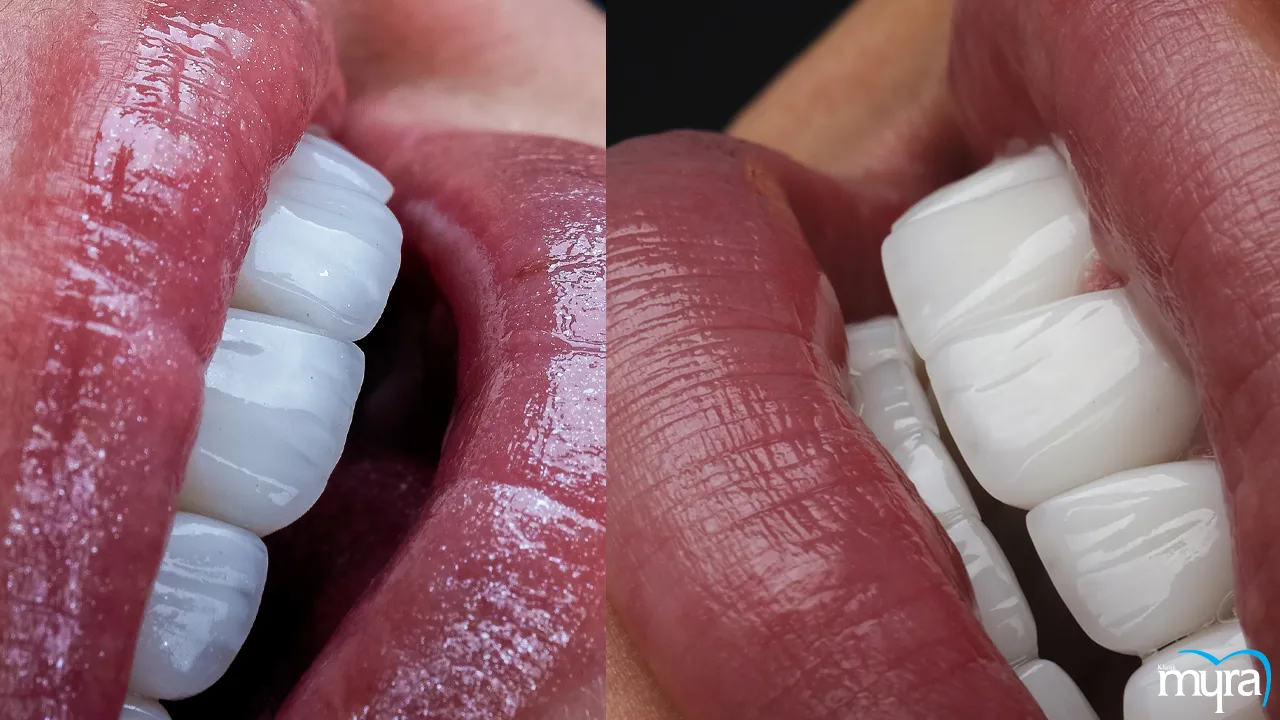
2. Composite Veneers
Composite veneers are thin facings crafted out of composite resin used in dentistry. The material is made of acrylic resin and finely-ground glass particles. They attach to the tooth's front surface in order to heighten its look. Composite resin offers the advantage of being moldable and adaptable in colour, allowing dentists to fabricate and coordinate the veneers straight onto the tooth's surface for immediate results.
Dentists recommend composite veneers to patients desiring a hassle-free and reversible remedy for aesthetic dental problems. They are great at addressing minor issues, such as gaps between teeth and discoloration. Their adaptability makes such veneers a top choice for patients who want rapid improvements without extensive tooth reshaping or removal.
Teeth undergo a light preparation during the installation process. Dentists apply a bonding agent to the tooth surface. The composite material then adheres to the agent. A curing light hardens the composite, ensuring it remains firmly attached.
Composite veneers have a commendable success rate, even more so when patients maintain them with regular dental check-ups and good oral hygiene. They have a lifespan that ranges from 5 to 7 years. The prices fluctuate between £210 and £1,260 per tooth on average. Their relative affordability and immediate results make them a popular choice for cosmetic dental enhancements.
3. Zirconia Veneers
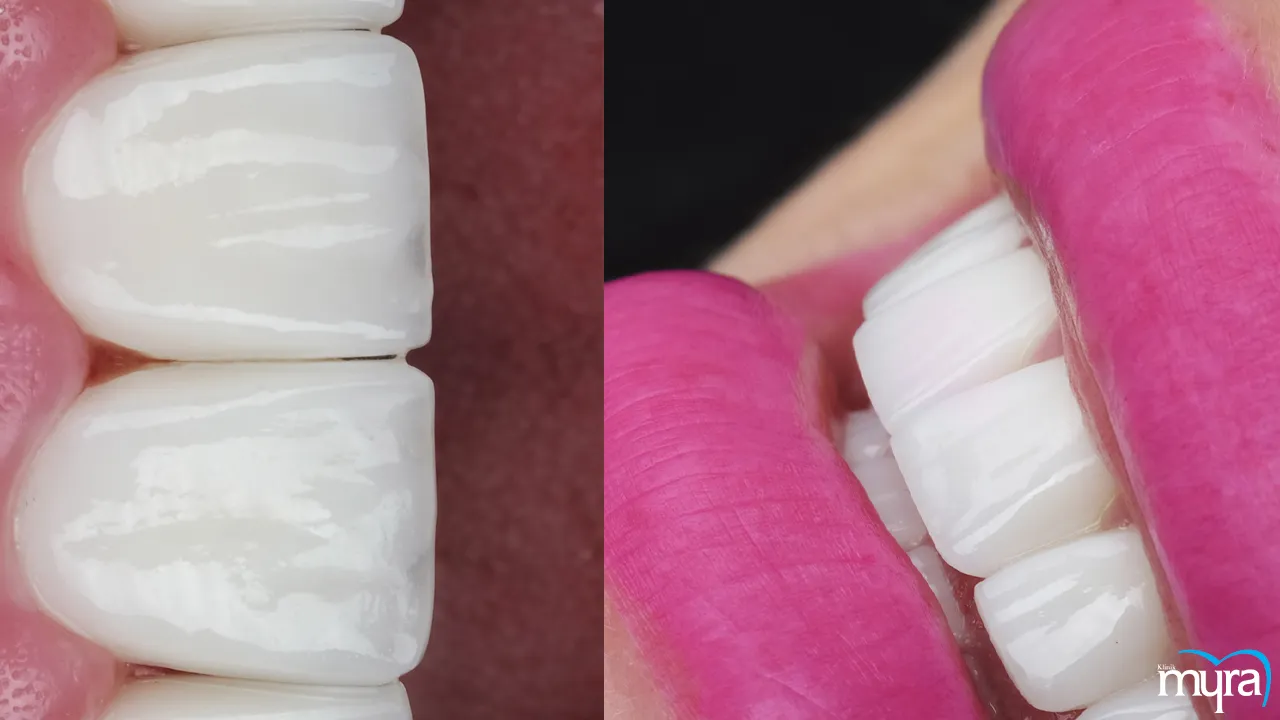 Zirconia veneers are thin protective coverings made from zirconia, a ceramic material that is durable and opalescent. Zirconia veneers adhere to the fronts of teeth to make them look better. The material is renowned for its robustness and long-lasting nature, rivalling natural enamel's durability while offering a high degree of translucency that mimics the appearance of real enamel.
Zirconia veneers are thin protective coverings made from zirconia, a ceramic material that is durable and opalescent. Zirconia veneers adhere to the fronts of teeth to make them look better. The material is renowned for its robustness and long-lasting nature, rivalling natural enamel's durability while offering a high degree of translucency that mimics the appearance of real enamel.
Dentists often recommend zirconia veneers to patients looking for a semi-permanent way to address problems with their smiles. They are an excellent alternative for individuals aiming to correct issues such as tooth misalignment and stains. The exceptional durability makes them ideal for patients who grind their teeth or have a forceful bite, situations where other veneer materials face a higher risk of damage.
A thin layer of the tooth's enamel is removed during the installation of zirconia veneers to ensure a perfect fit. A dental adhesive helps in their secure bonding to the tooth. The materials involved in the process include bonding cement and sometimes a light-cured resin, which ensures their firm adherance to the tooth.
The success rate of zirconia veneers is high due to the material's inherent strength. With proper care and maintenance, these veneers last for many years, often surpassing a decade. They cost around £220 in Turkey, with other territories demanding double that, such as the UK and Germany. They present a significant initial investment, but their longevity and aesthetic appeal make up for it.
4. Snap-On Smile
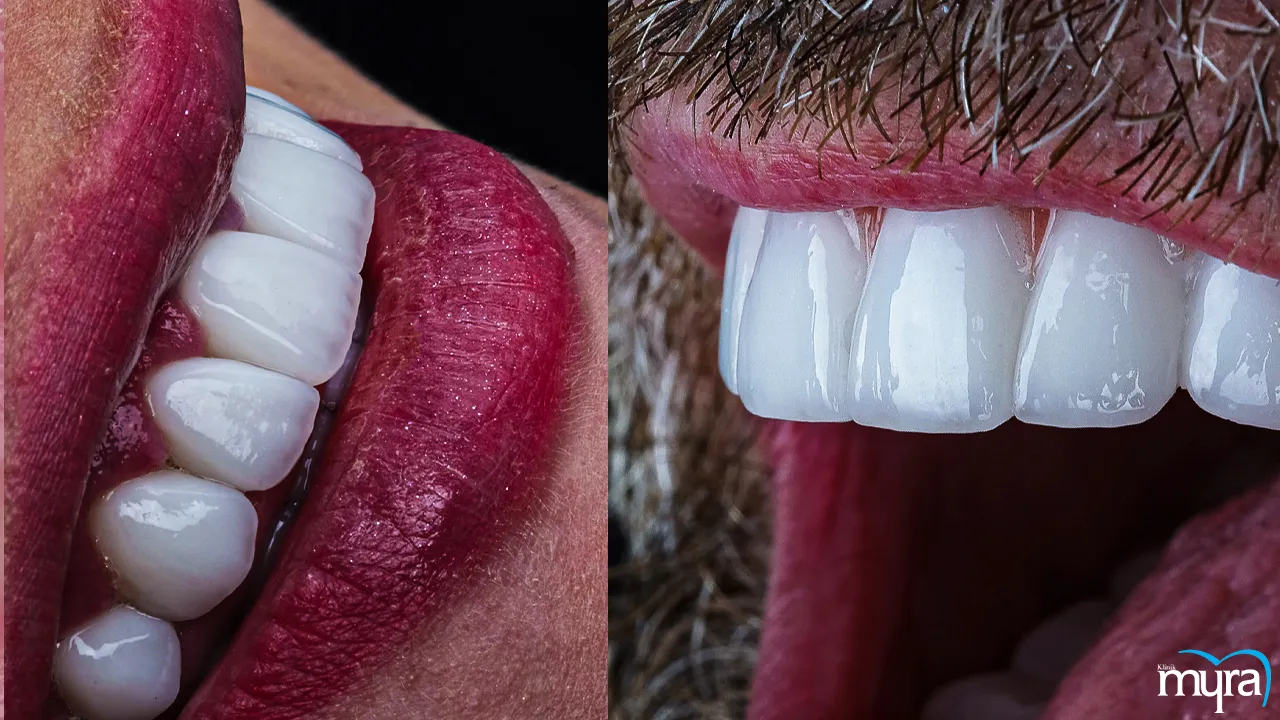 Snap-On Smile is a removable dental appliance designed to fit over the natural teeth. The appliance doesn’t require any invasive procedures, as it just clips onto the teeth. It is crafted from a proprietary resin material, producing a thin and durable cover that provides an instant solution for a variety of dental imperfections.
Snap-On Smile is a removable dental appliance designed to fit over the natural teeth. The appliance doesn’t require any invasive procedures, as it just clips onto the teeth. It is crafted from a proprietary resin material, producing a thin and durable cover that provides an instant solution for a variety of dental imperfections.
Dentists recommend Snap-On Smile to individuals looking for a non-invasive and reversible cosmetic dental solution. It serves as an ideal choice for patients with minor aesthetic issues with their teeth, such as chips and discoloration. It’s a viable option for patients looking to improve their smiles without going through a rigorous process.
The Snap-On Smile does not require adhesives, cement, or bonding agents for installation, unlike traditional veneers. It relies on its precise fit to stay in place over the natural teeth, making it a hassle-free and wearable solution. A precise fit is achieved through an impression of the teeth.
The success rate of the Snap-On Smile is high, lasting longer with high-quality care and handling of the appliance. It lasts for years with diligent maintenance, reaping its aesthetic and functional benefits for longer. The cost falls in the range of £1,000 to £2,910 for the upper and lower arches. The cost includes everything, from the initial consultation and impression to the final fitting.
5. Microthin Veneers
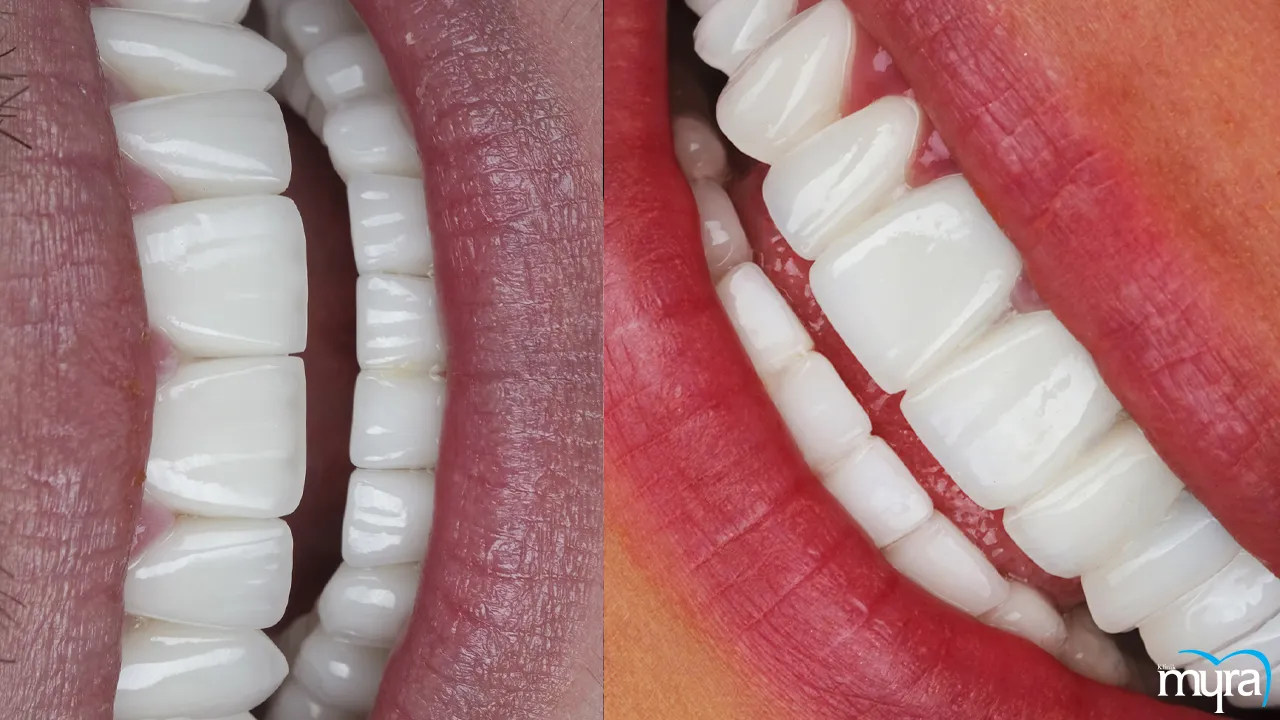 Microthin veneers are ultra-thin dental prosthetics designed to cover the front surface of teeth. They are crafted from high-quality porcelain, enhancing the appearance of teeth without the need for extensive enamel removal. Their thinness allows them to mimic the natural translucency of tooth enamel, offering a realistic and aesthetically pleasing result.
Microthin veneers are ultra-thin dental prosthetics designed to cover the front surface of teeth. They are crafted from high-quality porcelain, enhancing the appearance of teeth without the need for extensive enamel removal. Their thinness allows them to mimic the natural translucency of tooth enamel, offering a realistic and aesthetically pleasing result.
Dentists recommend microthin veneers to individuals desiring cosmetic improvements without significant tooth alteration. They are ideal for addressing minor misalignments and discolorations. Their design minimises the removal of tooth structure, making them a conservative approach to aesthetic dentistry.
Installation of microthin veneers involves bonding them to the teeth using dental adhesive. The bonding process ensures they stay attached to the tooth's surface. Light-cured resin bonding agents enhance the bond between the veneer and the tooth, ensuring longevity and durability.
Microthin veneers have a high success rate, and with proper care and maintenance, they remain intact and look good for many years. Good oral hygiene practises and regular dental check-ups contribute to its lifespan. The cost starts at £525, making it a great investment for providing functional and cosmetic benefits for the teeth.
6. Palatal Veneers
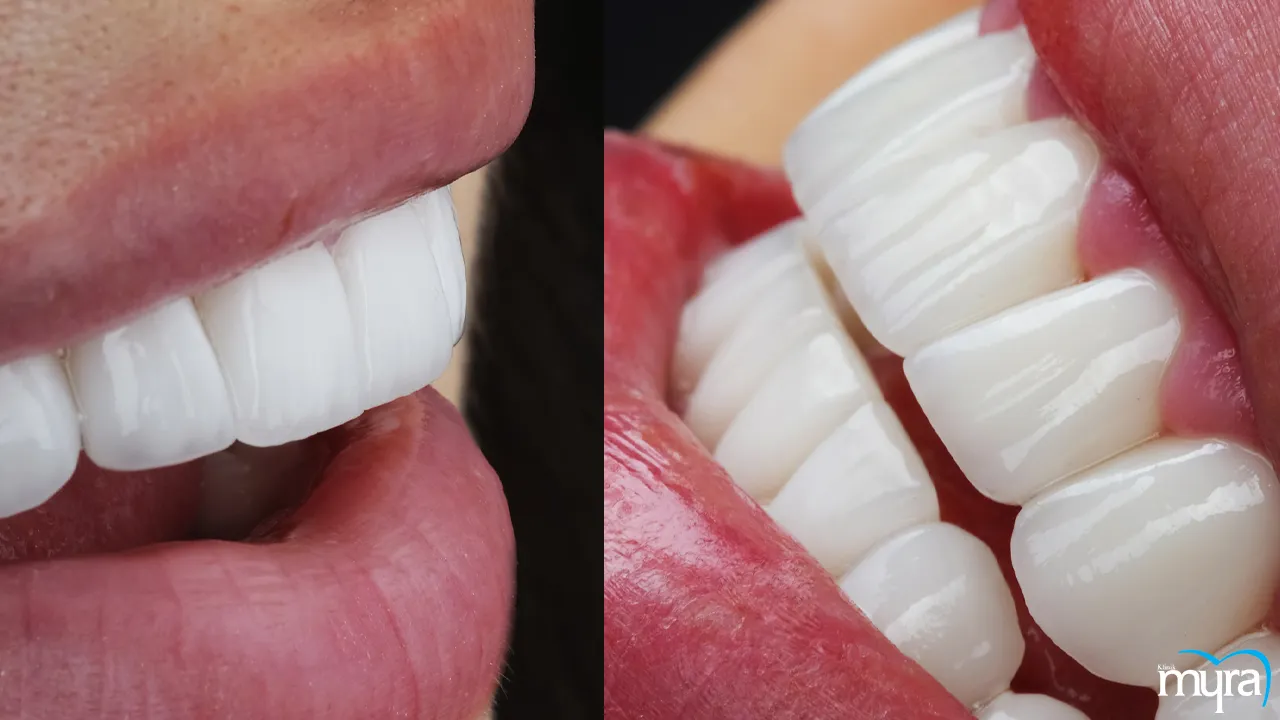 Palatal veneers are dental prosthetics placed on the palatal or inner side of the upper anterior teeth. They primarily consist of composite resin or high-quality porcelain. The material choice ensures durability and a pleasing aesthetic finish.
Palatal veneers are dental prosthetics placed on the palatal or inner side of the upper anterior teeth. They primarily consist of composite resin or high-quality porcelain. The material choice ensures durability and a pleasing aesthetic finish.
Dentists recommend palatal veneers for individuals with specific dental issues, such as eroded palatal surfaces due to conditions such as bruxism. They protect the inner surfaces of the teeth from further wear. Another group that benefits from palatal veneers includes wind instrument musicians, as the veneers facilitate better positioning and control over the instrument.
A dental adhesive bonds the veneers to the tooth's surface. The choice of adhesive varies depending on the type of veneer material and the specific requirements of the patient's dental condition. A light-cured resin bonding agent is applied to enhance the bond between the two.
Palatal veneer installations are safe and have high success rates. Adherence to post-operative advice factors into its lifespan, such as good oral hygiene. Patients invest at least £540 per tooth, but the investment lasts for up to 15 years.
7. Non-Prep Veneers
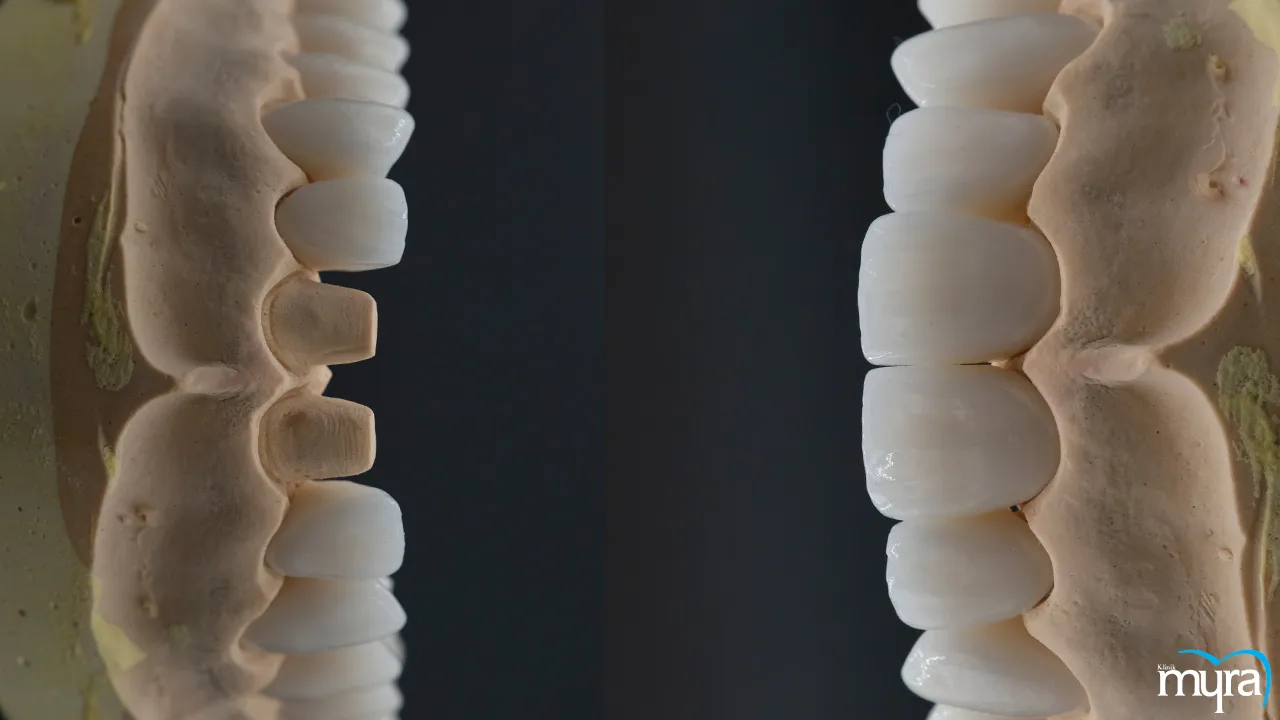 Non-prep veneers refer to thin dental coverings that are intended to enhance teeth's appearance without requiring significant tooth preparation or tooth structural reduction. Manufacturers create these veneers using high-quality porcelain. It ensures longevity and a natural appearance.
Non-prep veneers refer to thin dental coverings that are intended to enhance teeth's appearance without requiring significant tooth preparation or tooth structural reduction. Manufacturers create these veneers using high-quality porcelain. It ensures longevity and a natural appearance.
Dentists often recommend non-prep veneers to individuals who desire cosmetic enhancements without committing to the removal of tooth enamel. They work well for addressing minor imperfections, such as tooth gaps and misalignments. Patients who are apprehensive about permanent alterations to their teeth find non-prep veneers a suitable option.
The non-prep veneer installation process involves using a durable dental adhesive to bond the veneer to the tooth's surface. The procedure doesn't necessitate the use of local anaesthetics, unlike traditional veneers. There’s minimal discomfort due to the absence of tooth reduction.
Non-prep veneers do not require invasive procedures, factoring into their positive reception and high success rate. They have a lifespan of up to 10 years with proper care. They cost between £670 and £1,660 per tooth and offer a balance of convenience and aesthetic appeal.
8. Traditional Porcelain Veneers
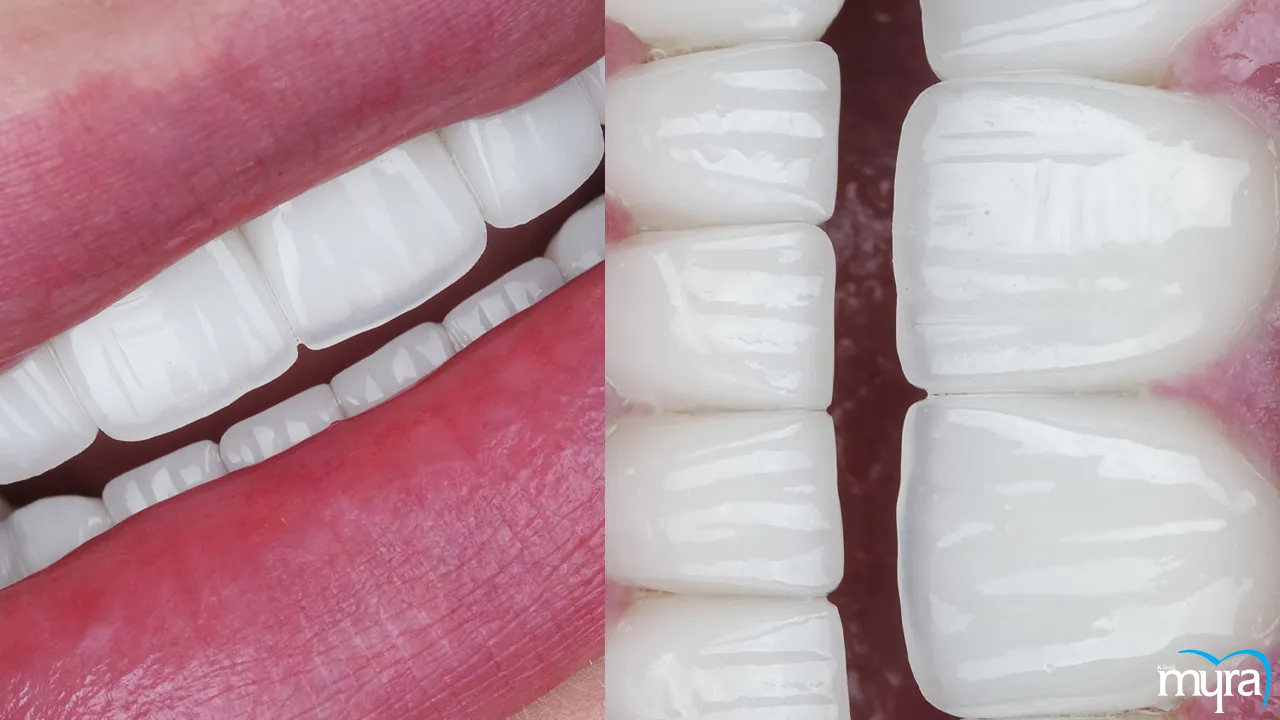 Traditional porcelain veneers are thin protective coverings constructed from premium porcelain. They mask imperfections by covering the tooth's front surface. They improve the tooth's look and serve as a fantastic option for patients looking to rectify issues, such as chipped or worn-down teeth. Porcelain has a natural tooth-like appearance and better stain resistance compared to other materials.
Traditional porcelain veneers are thin protective coverings constructed from premium porcelain. They mask imperfections by covering the tooth's front surface. They improve the tooth's look and serve as a fantastic option for patients looking to rectify issues, such as chipped or worn-down teeth. Porcelain has a natural tooth-like appearance and better stain resistance compared to other materials.
Dentists recommend traditional porcelain veneers to patients seeking a cosmetic enhancement that lasts. They are ideal for patients who wish to transform their smiles without performing extensive dental procedures. Patients with intrinsic stains, which are resistant to conventional procedures for whitening, get substantial benefit from porcelain veneers.
Traditional porcelain veneer installation involves using a dental adhesive to have it attached to the tooth. A small amount of natural tooth enamel is removed prior to installation for the veneer’s accommodation. It guarantees a seamless fit and appearance.
The success rate of porcelain veneers is high, lasting up to 15 years or even longer with proper care. Costs vary per region, with them being cheap in Turkey at £165 per tooth. They offer semi-permanent enhancements to the smile at a low price, even more so in certain regions.
What Are the Advantages of Having Veneers?
The advantages of having veneers are listed below.
- Enhanced Aesthetics: Veneers provide a significant improvement in teeth’s appearance. They are a reliable solution for several issues, from stained and chipped teeth to misaligned teeth, resulting in a better-looking smile. The osmetic procedure helps restore confidence and self-esteem for many individuals, allowing them to smile without hesitation.
- Durability and Longevity: Veneers offer a long lifespan, even more so when crafted with stronger materials, such as zirconia. They endure many years of use with proper care, making them a reliable choice for patients seeking a lasting solution to their dental imperfections. Their resistance to stains and chipping adds to their longevity.
- Minimal Tooth Alteration: Veneers require minimal alteration of the original tooth structure compared to other cosmetic procedures. Certain types, such as Lumineers and no-prep veneers, demand little removal of the tooth enamel, if at all necessary. Minimal intervention allows for the retention of patients’ natural teeth and has the added benefit of protecting them.
- Stain Resistance: Veneers resist staining from common culprits such as tea and wine, even more so when using certain materials such as porcelain. Natural teeth absorb the stains over time, but veneers maintain their brightness and lustre despite exposure to such elements. They allow the easier maintenance of teeth’s white and vibrant colour without frequent whitening treatments.
- Correction of Multiple Imperfections: Veneers address discolorations and rectify various other imperfections, from chips and gaps to misalignments. A single procedure has the capacity to solve several dental issues at once, offering a comprehensive solution for patients looking to enhance their oral appearance.
What Are the Disadvantages of Having Veneers?
The disadvantages of having veneers are listed below.
- Sensitivity Issues: Some patients report experiencing increased tooth sensitivity after the placement of veneers. Cold or hot substances cause discomfort or sharp and sudden pain. The removal or thinning of the enamel during the veneer application process exposes the dentin, leading to heightened sensitivity in some cases.
- Irreversible Process: The procedure for placing veneers involves the removal of a small portion of the natural tooth enamel. The removal is permanent, as it does not grow back. Patients who choose veneers commit to them for life or must seek alternative dental solutions if they decide to remove them.
- Risk of Damage: Veneers are durable but remain susceptible to damage. Extreme force on the teeth, from biting on hard objects and grinding teeth to trauma to the face, carries the risk of cracking or chipping the veneer. Damages are not easy to repair and often require a complete replacement.
- Limitation in Colour Adjustment: Altering the veneers’ colour becomes a challenge once dentists cement them in place. Staining of the underlying natural tooth or the desire for a brighter shade necessitates the replacement of the veneer. Individuals must be sure about their colour choice from the outset.
- Expense: Veneers are an expensive dental procedure. The price varies depending on the material and the dentist's expertise, but involves a significant investment across the board. Insurance plans rarely cover cosmetic procedures, meaning patients bear the full cost out of pocket.
How Long Do Dental Veneers Last?
Dental veneers last for up to 15 years on traditional ones, even longer with proper care. Longevity is influenced by numerous variables, from the material chosen and the skill of the dentist to the patient’s oral hygiene practises. For example, porcelain veneers tend to outlast composite resin ones due to their strength and resistance to staining.
Periodic dental examinations and expert-facilitated cleanings help ensure that the veneers remain strong and attractive. Proper oral hygiene, including regular flossing and brushing, contributes to their longevity. Bad habits, from biting on hard objects and using teeth as tools to excessive grinding, jeopardise the veneer's lifespan.
External factors, such as consumption of staining foods and beverages, influence the veneers’ longevity. For example, regular indulgence in coffee and tea without regular cleaning leads to discoloration over time. Smoking has a similar effect, causing yellowing or browning. Avoidance of such activities helps lessen the risk of discoloration.
Dental veneers last a long time, but not forever, showing signs of wear and tear as they approach the end of their lifespan. Minor chipping or detachment from the tooth surface are indications that replacement is necessary. Replacing worn veneers restores the appearance and functionality of teeth. It ensures continued protection of the underlying tooth structure and maintains the individual's desired look.
Dental veneers provide a long-lasting solution for cosmetic and functional dental concerns. Their longevity, however, remains subject to various factors. Regular dental care and a proactive approach to replacements help maximise their lifespan and maintain optimal oral health.
How to Maintain Dental Veneers for Long-Lasting Results?
There are several things to do to maintain dental veneers for long-lasting results, such as practising good oral hygiene and scheduling regular dental check-ups. Practising good oral hygiene, such as brushing teeth twice a day with a non-abrasive toothpaste, helps prevent the buildup of plaque and tartar. Incorporating flossing into a day-to-day routine aids in removing food particles stuck between teeth, further ensuring the health of natural teeth and veneers.
Hard foods are responsible for damaging the teeth and veneers. Crunching hard foods, from ice and hard candies to some nuts, increases the risk of chipping or cracking the veneers. Cutting such foods into manageable pieces and chewing with the back teeth reduces the risk of damage.
Regular dental check-ups and cleanings help monitor the condition of veneers. Dentists assess the integrity of the veneer and check for any signs of wear and tear during checkups. They offer professional cleaning, which helps keep veneers and natural teeth in optimal condition. Any minor issues detected during the visits allow for prompt interventions, ensuring veneers last longer.
Using protective gear during sports activities or other high-impact events protects veneers from unexpected trauma. For example, a custom-fitted mouthguard offers protection against impacts that risk chipping or cracking the veneers. Limiting the consumption of staining foods and beverages ensures veneers retain their bright and natural appearance. Consuming coffee and tobacco in moderation and rinsing the mouth with water afterward aids in minimising discoloration.
Dental veneers have lengthy lifespans when cared for. Their longevity necessitates forming good habits, from daily care and regular professional interventions to mindful behaviours. Adhering to the guidelines maximises their durability and promotes oral health.
Can Dental Veneers Be Removed or Reversed?
Yes, dental veneers can be removed or reversed. The drawback is that the removal or reversal is not as simple and easy as the first time they’re applied. Placing veneers on the teeth requires the removal of a minimal amount of enamel from the tooth's exterior to ensure a snug fit. The removal indicates that the majority of veneered teeth are forever altered.
Patients seeking to reverse veneers face two choices. One is to opt for new veneers, and the other is to get dental crowns. The underlying tooth does not look good or does not have enough structure for everyday function without some form of coverage. The enamel removal is irreversible, meaning the tooth’s original state prior to veneer installation is not restorable.
The removal of veneers requires careful consideration and is best discussed with the dentist’s evaluation. Dentists assess the health and structural integrity of the tooth beneath the veneer. They then offer guidance on the best course of action to achieve the desired results while maintaining the health and functionality of the teeth.
Veneers last many years with proper care, but they do not last forever. Replacement or removal becomes necessary as they wear out or if oral health issues arise. The decision to reverse or remove veneers is a substantial one due to the permanent changes made to the teeth during the initial veneer application process.
How Do Dental Veneers Compare to Teeth Whitening?
Dental veneers are comparable to teeth whitening in the sense that they are dental treatments that are intended to improve the look of a person's teeth. The methods aim to address discolorations and provide a more radiant smile, but they have different applications and results. Dental veneers consist of fine composite resin or porcelain-based coverings attached to the tooth's front surface.
Dental veneers mask a variety of dental imperfections. They address stubborn stains that resist traditional bleaching methods and mask other issues such as minor misalignments and cracks. They are a comprehensive repair method that transforms the way teeth look. Veneers have lifespans that last many years when maintained well.
Teeth whitening focuses on lightening the shade of teeth. The procedure uses peroxide-based agents that work by breaking down and removing stains from the tooth's surface. Results depend on factors ranging from the type of stain and the chosen method to individual dental health.
Certain patients experience significant lightening in just one session, while others require multiple treatments. Teeth whitening provides patients with a safer method for improving their smile's luminosity without changing the teeth’s structure or shape. Periodic upkeep and touch-ups must be performed to preserve the whitening effect.
Dental veneers are more expensive due to their custom fabrication and the precision required in their application. Teeth Whitening is a cheaper option but incurs additional costs with repeated sessions. A decision between the two hinges on the desired outcome and individual dental needs. Consulting with a dentist is ideal to determine the most suitable choice for achieving the desired outcome.
What Is the Difference Between Dental Veneers and Dental Laminates?
The difference between dental veneers and dental laminates centres on their materials and purpose, among others. Veneers are custom-fabricated covers intended to mask the front surfaces of teeth to enhance their visual appeal. Porcelain veneers are appreciated for their ability to replicate the light-reflecting properties of natural teeth. Composite resin veneers are cheaper but do not have the same level of translucency or stain resistance.
Dental laminates are sometimes called ultra-thin porcelain veneers. The thin nature makes for a less invasive alternative because they require very little, if any, removal of the original tooth enamel before application. The translucence of dental laminates gives them a distinct advantage in mimicking the appearance of natural teeth, making them a favourite for patients seeking subtle enhancements.
Durability is a point of comparison between the two. Dental veneers and laminates are long-term solutions for dental cosmetic concerns, but veneers have a longer lifespan of up to 15 years or even longer. Dental laminates are thin, making them more susceptible to cracks or breaks, even more so when biting with a strong force.
The method of application is another differentiation. Dental veneers allow for direct integration into the tooth with little work required, as is the case with composite resin. Dental laminates need a carefully-prepared tooth surface to achieve optimal adhesion and aesthetics.
Dental veneers and laminates are effective solutions for dental issues that are cosmetic in nature. The decision to opt for Dental Veneers vs Laminates hinges on several factors, from specific requirements and desired results to the advice of a dental specialist. The ideal choice involves consideration of the patient’s oral health status and desired aesthetic outcome.





